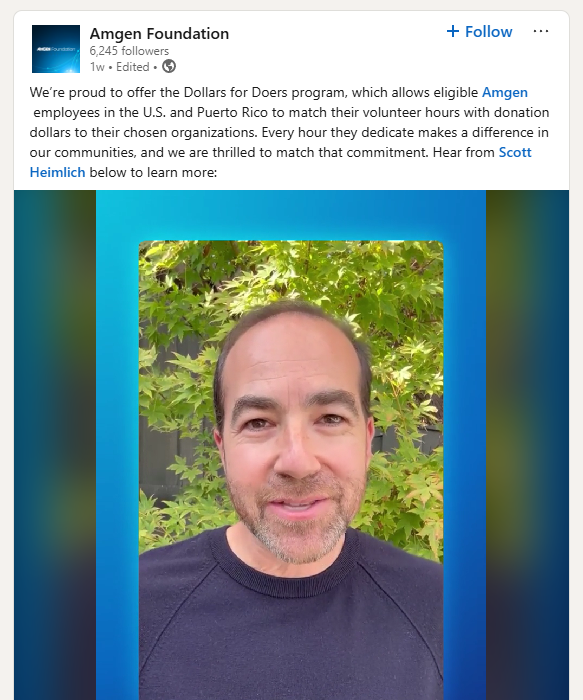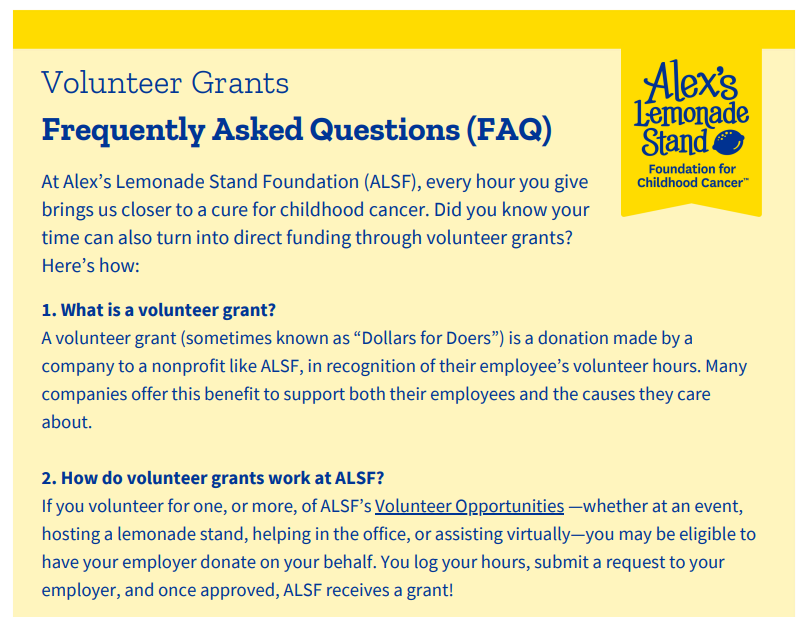
Fundraising professionals and volunteer coordinators alike often feel intense pressure to widen their organization’s funding base. At the same time, they strive to make volunteering more meaningful for highly skilled, passionate individuals. Creating a nonprofit volunteer grant strategy addresses both of these needs, empowering nonprofits to turn volunteer activity into a substantial, sustainable stream of revenue.
Volunteers who qualify for these grants are not only dedicated but also often possess specialized skills and workplace connections. If you’ve ever wished your organization could increase fundraising without adding major events or putting more strain on donors, volunteer grants are a solution hiding in plain sight. However, many organizations never fully capitalize on volunteer grants due to information gaps, unclear processes, or a lack of internal alignment.
Therefore, in this guide, you’ll discover actionable strategies for building or refining a nonprofit volunteer grant strategy that truly works. Each section delves into practical steps you can take to:
- Evaluate your current readiness and discover untapped revenue potential
- Educate and empower your volunteers, making participation seamless and rewarding
- Streamline and automate your internal processes for maximum efficiency
- Forge partnerships with corporate employers, expanding both fundraising and reach
- Track, evaluate, and optimize your strategy so it keeps growing alongside your mission
If you’re ready to unlock new funding and recognize your volunteers in more meaningful ways, read on for a blueprint you can implement at your organization right away.
Assessing Your Current Volunteer Grant Readiness
Before you can launch a strong nonprofit volunteer grant strategy, you need a clear picture of your starting point. Many organizations jump straight into outreach efforts without first examining their volunteer pool, current outreach methods, or available processes. Taking the time to analyze where you stand helps set achievable goals, prevents headaches, and lets you direct resources to high-yield opportunities.
Audit Your Volunteer Base and Employer Information
Begin by gathering a comprehensive list of your active volunteers, including their names, contact details, and, especially, their current employers. This data provides insight into which volunteers may be eligible for volunteer grants, helping you segment your outreach accordingly. From there, integrate employer information capture into your onboarding forms and annual volunteer surveys. For existing volunteers, consider a short, friendly survey asking about their current workplaces and what they know about their employer’s volunteer grant programs.
Once you have this data, review the list of employers against well-known corporate giving program databases, such as those listing the top companies offering volunteer grants. Cross-referencing this information helps you estimate your potential pool of grant-eligible volunteers and establishes the groundwork for targeted outreach.
Analyze Your Current Outreach and Identify Gaps
Carefully examine where, when, and how you talk to volunteers about grant opportunities. This includes welcome emails, training materials, volunteer handbooks, your website, and event communications. Walk through the volunteer grant process yourself to spot confusing steps or missing information. Are submission links easy to find? Are the instructions clear enough for someone new to the volunteer grant process? Talk to staff or volunteers who have experienced the task before, and ask them where bottlenecks or frustrations occur.
Document your entire volunteer grant workflow in a one-page process summary. This resource will later help you train staff and identify areas for improvement.
Set Baseline Metrics and SMART Goals
Gather baseline data on your current performance. How many volunteers qualify for grants? How many volunteer grant applications were submitted or approved last year? What is the total dollar amount generated? Use these numbers to establish SMART (Specific, Measurable, Achievable, Relevant, Time-bound) goals for improvement. For instance, aim to increase volunteer grant submissions by 25% within the next 12 months.
By establishing a factual case for your leadership or board, you’ll gain stronger buy-in and keep your team focused once you’re ready to roll out bigger changes. Once you’ve evaluated your organization’s readiness, you can turn your attention to the people who make these opportunities possible: your volunteers.
Educating and Empowering Your Volunteers to Request Grants
After identifying who might be eligible and clarifying your internal process, the next big challenge is education. Most volunteers are completely unaware that their time can double (and sometimes triple) a nonprofit’s financial impact. Even those who know may not act simply because the process for doing so isn’t clear.
Removing these barriers is crucial for creating a nonprofit volunteer grant strategy that stands out.
Use Targeted Communication to Raise Awareness
Make sure every volunteer understands what volunteer grants are, how easy it is to participate, and why their involvement matters. Highlight real-world employer examples. Companies like Amgen Foundation, Bread Financial, and Navy Federal Credit Union actively promote their grant programs, as seen on sites like LinkedIn. Mentioning or sharing examples like these reassures volunteers that grant programs are common and accessible.

From there, be sure to integrate messaging about volunteer grants into volunteer orientations, volunteer handbooks, and even post-event communications. For example, add a section to training slides: “Did you know many companies will donate generous sums of money for every hour you volunteer with us?” Provide a link where they can check their eligibility, such as your own volunteer grant page, complete with a corporate giving database.
Simplify the Volunteer Grant Application Process
Complexity deters action. Create easy-to-follow step-by-step guides tailored for your most common employers. Post these on a dedicated web page featuring frequently asked questions, resource lists, and links to employer-specific portals. Update this resource as you discover new company programs from volunteers.
Here’s an example from Alex’s Lemonade Stand!

You can also assign a knowledgeable staff member or seasoned volunteer as the go-to person for all volunteer grant-related questions. Offer one-on-one support for first-time applicants to ensure no one gets stuck in the process.
Personalize Outreach and Celebrate Achievements
Personal recognition and peer influence are powerful motivators for action. Use milestone-based triggers (such as when a volunteer logs 10 or 20 hours) to automatically send a congratulatory message with clear next steps for submitting a grant application.
Share success stories regularly, such as “Thanks to Emily, a Bread Financial employee, we received a $1,000 volunteer grant this spring.” With permission, highlight these stories in emails and on your website to inspire others. Thank both the volunteer and their employer in communications, showing appreciation for their combined effort.
By combining clear information, accessible processes, and personal touch points, you empower volunteers to participate enthusiastically and help them spread the word to others in your network.
Streamlining Internal Processes and Leveraging Technology
Creating a nonprofit volunteer grant strategy is much easier when you have clear internal ownership and efficient processes. Streamlining workflows and embracing automation ensures that your staff and volunteers spend less time on repetitive administration and more time driving impact.
Define Roles and Document Procedures
First, clarify who in your organization is responsible for what when it comes to volunteer grants. Assign a dedicated team member (or small group) to handle volunteer hours tracking, manage incoming grant paperwork, and communicate with corporate contacts. For smaller nonprofits, these may be shared responsibilities, so make sure the expectations are documented and everyone knows their role.
Develop a straightforward checklist or flowchart that outlines the entire grant process, from volunteer sign-up through to submission, employer confirmation, and the arrival of funds. Keep this resource simple and share it widely with all staff and key volunteers.
Adopt Volunteer Management and Matching Gift Tools
Digital tools are no longer a luxury for efficient nonprofits. Volunteer management platforms can track attendance, hours, and volunteer engagement in real time. Integrating these systems with platforms that specialize in automated volunteer grant solutions allows you to link eligible volunteers with the correct employer portals and automatically prompt them to submit their hours for grants.
On your organization’s website, embed employer lookup tools, such as those provided by Double the Donation, so that volunteers can quickly check their eligibility. According to recent research, 40% of Fortune 500 companies offer volunteer grants, making these integrations highly effective at increasing participation.
Train and Support Your Team
Training is essential, especially when introducing new technology or updated processes. Run short training webinars, produce easy-to-follow video guides, and send regular updates to keep your team informed. Highlight new tools or resources and provide opportunities for staff to ask questions or give feedback.
Recruit volunteer grant “champions” who have successfully completed the process. These internal advocates can provide guidance, mentor their peers, and address questions, helping others feel more confident.
Review and Improve Processes Regularly
On a regular basis, solicit feedback from everyone involved: staff, volunteers, and employer contacts. Use this feedback to adjust instructions, streamline forms, and improve communication materials. Regularly updating your processes helps prevent frustration and ensures your grant program remains effective at every scale.
With efficient internal systems and the right tools in place, you’re prepared to build meaningful relationships with corporate partners: a key next step for expanding both funding and your reputation in the community.
Engaging Corporate Partners and Employers
Corporate partners are critical to making volunteer grant programs work. The companies employing your volunteers ultimately fund the grants. By building strong relationships with these entities, you ensure your nonprofit stays top of mind when employees initiate their grants.
Identify and Prioritize Major Employers
Review your updated volunteer database to see which companies are most represented in your supporter community. Segment and prioritize outreach to those employers first, and remember that your existing volunteers may be willing to provide warm introductions to their employers.
Additionally, be sure to monitor corporate responsibility and giving announcements, particularly on sites like LinkedIn, to keep abreast of new partnerships, changes in volunteer grant requirements, or opportunities to participate in special initiatives.
Build Relationships with HR and CSR Representatives
Reach out to human resources (HR) and corporate social responsibility (CSR) representatives by introducing your nonprofit and explaining the impact their employees have already made through various volunteer initiatives. Share stories of previous grants or highlight the skills and expertise that supporters from their company have provided.
For example, many nonprofits that partner with Navy Federal Credit Union have benefited from maintaining ongoing communication, resulting in increased grant funding and higher employee engagement. Being proactive and transparent in thanking companies for their support strengthens these connections further.
Recognize and Deepen Partnerships
Publicly thank and celebrate companies that provide volunteer grants on your digital platforms, in newsletters, and at signature events. Recognition boosts the employer’s internal morale and may attract more volunteers.
Consider collaborating with corporate partners on volunteer days, skills-based “volunteering sprints,” or other joint initiatives that raise your nonprofit’s profile and strengthen the partnership over time. From there, you can use your partnerships as a springboard to discuss other corporate giving opportunities, such as workplace donation campaigns or event sponsorships.
Tracking Outcomes and Optimizing Your Nonprofit Volunteer Grant Strategy
A successful nonprofit volunteer grant strategy is never truly finished. Instead, continued measurement, feedback, and adaptation keep your program growing and ensure you don’t leave any opportunity untapped.
Measure Key Metrics and Analyze Results
Consistently track the financial impact of your volunteer grants. This includes the total dollar value received, the number of volunteers who participate, the number of grant applications submitted, approval rates, and the average size of each grant.
Then, benchmark your performance against sector averages, if possible. The volunteer statistics from Double the Donation can offer valuable context on how your organization stacks up and where you might want to focus your efforts.
Get Regular Feedback from Stakeholders
Feedback from staff, volunteers, and corporate partners is essential for program growth. Use short surveys after each event or submission cycle to ask what worked well and where barriers remain. Offer anonymous feedback opportunities to increase candor and gather honest suggestions.
From there, you could even interview your largest employer partners once a year to ensure their systems and requirements align with your internal processes and ask about upcoming changes. Empower experienced volunteer grant-achieving volunteers to serve as mentors or ambassadors. Their firsthand stories and advice will inspire others to participate in the programs.
Refine Communication and Test New Approaches
If your data or feedback suggests confusion among volunteers, revise your outreach and update resource guides or instructional videos. Try different approaches, such as including volunteer grant prompts in shift sign-up confirmations or sending one-minute explainer videos in thank-you emails.
Test which tactics yield the best results, and roll out those strategies to your wider volunteer base.
Plan for Sustained Success
Schedule annual or quarterly reviews of your volunteer grant strategy. Convene staff and key volunteers to review outcomes, strategize for the next year, and document best practices. Keep a shared resource library, such as a Google Drive folder or internal wiki, for all updated guides, forms, and feedback.
Publishing your lessons learned and recent achievements in annual reports or board updates ensures accountability and celebrates progress.
Conclusion: Elevate Your Volunteer Grant Strategy
Unlocking the full value of volunteer grants requires more than awareness. It takes a thoughtful, data-backed plan that blends internal readiness, volunteer empowerment, efficient processes, and strong partnerships. By assessing your current capabilities, clearly communicating with volunteers, streamlining your systems with technology, building proactive employer relationships, and continually tracking and refining your approach, you genuinely create a nonprofit volunteer grant strategy that delivers for your mission.
Every dollar raised helps you grow your impact and recognize the skilled volunteers who make that possible. As next steps, consider implementing even one or two of these strategies this quarter and see the difference for yourself.
The time to unlock your organization’s hidden potential is now. Your volunteers (and your mission) are worth it.
Unlock Your Nonprofit’s Corporate Volunteering Potential: Free Download
Ready to take your volunteer grant strategy to the next level? Download Double the Donation’s comprehensive guide, “Leveraging Corporate Volunteer Incentives,” to discover actionable steps and strategies that can maximize the impact of your supporters and their corporate volunteer opportunities.
This guide will walk you through identifying eligible volunteers, educating them on the volunteer grant process, and building strong partnerships with corporate employers to boost your nonprofit’s revenue.
